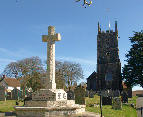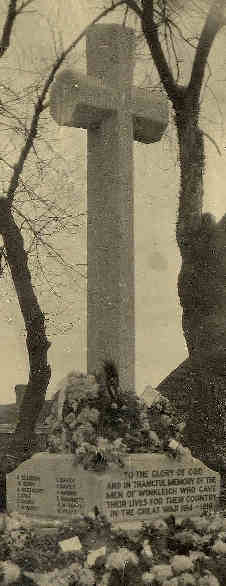
|
| HOME PAGE |
| MEMORIAL CROSS |
HISTORY of the CROSS |
| ROLL of HONOUR |
| LINKS |
| The History of the Cross
Our War Memorial and how it came to be built. As many in Winkleigh know, much progress is being made with the British Legion’s project of recording the lives and stories of the men whose names are proudly inscribed on our beautiful cross. 90 years ago those heroes - and indeed all those who went from Winkleigh and who somehow survived the war - were very much in the minds of the whole village, when, on April 1st 1919, a meeting was held in the school to decide what form the war memorial for Winkleigh would be appropriate. The committee was composed of the Vicar, the Rev. Frank Nesbitt who had only just arrived, Mr Raymont, Dr. Glover, Colonel Alexander, Mr Lane and Mr E.J.Saunders. Mr. Raymont proposed a stone, others were more in favour of a village hall, or reading room. Everything was to depend on how much could be raised. These were difficult times, however. Prices had risen alarmingly over the past five years, wages were low, and all had suffered from war’s privations. The cross was built, but the idea of a village hall had to wait for much longer, and is another story. Meanwhile Colonel Alexander had completed his research and records of those who had died, as well as for all who had served, presenting the Roll of Honour to the church, where it hangs to this day. The Parish Magazine for May 1919 comments on the difficulties of this task. The Rev. Nesbitt’s wish that the full details of every man’s service should be recorded for future generations was never totally fulfilled, and it is as a small tribute to his efforts at that time and indeed to the memory of the men themselves as we rapidly approach the centenary of the conflict, that the Winkleigh British Legion are determined that the full information should be available for all to see. The design of the monument was a very important matter. The architect chosen was Mr. Herbert Read of Exeter. It seems that much discussion took place in the village between those who wanted a memorial in the churchyard and those, led by Colonel Alexander, who considered it more appropriate to have a civic memorial in the Square. The Vicar, however, was quite determined on a cross symbolising the sacrifice made, and made frequent references to the ‘Calvary’ of the horrendous losses in the war. In the event everyone agreed on the design, and permission to site the cross just inside the west gate was obtained from the vestry, but there were many delays as Mr Read was much in demand building memorials in many nearby villages. Costs mounted. By January 1920 the Rev. Nesbitt recorded in the Parish Magazine: Later we read: ‘The Cross will cost £190 but in addition to this there will be the cost of a concrete foundation, the haulage from Eggesford station, and the inscription in letters of lead which will include the names of all the men from this parish who gave their lives for their country in the Great War. As we have already about £80 in hand, we shall have to raise about £135. This seems rather a large sum but it is really very small compared with the sacrifice which has been made for us, and I feel sure that we shall all contribute very readily and as liberally as we can. We all want our Memorial to be a worthy one.’ It was Colonel Alexander who made it all possible, by organising the fund raising. By May 1920 £215 had been collected. The Vicar remarked hopefully: The dedication service was originally scheduled for Thursday January 6th 1921 (a Thursday was early closing day for the shops) but took place one week later, because severely bad weather had delayed the final delivery. Neither the Bishop of Crediton nor the Archdeacon of Exeter could be present, but happily the Rev. Edmonds, who had known the men so well, came to perform the ceremony. There was a massive attendance, both at the 8 o’clock communion and in the churchyard at 3.00 pm. The Rev. Nesbitt was justifiably proud of what was achieved. He wrote that month: 50 comrades led the procession into the churchyard. The Cross was draped in a full-sized Union Jack, brought to Winkleigh by the Rev. S.F. Streatfield, a great friend of the Vicar when they both served at Buckfastleigh. Enlisting as a padre, Streatfield had rescued the flag from the British Consulate in Ghent on October 12th, 1914, just as the last Allied soldiers were leaving the town and the German cavalry were galloping through, a real 'Boys' Own' adventure story. The cross was unveiled by Col. Alexander and then solemnly dedicated by Mr. Edmonds to the Glory of God, and in thankful memory of the men of Winkleigh who gave their lives for their country in the Great War. The Parish Magazine recorded the story. ‘Few of us are likely to forget the touching and impressive words of our late Vicar, who recalled the sad and anxious days when he was with us, and spoke of the comfort he was privileged to bring to many a sorrowing home. The Cross would always remind us of those whose names were inscribed upon it, and should help to draw our hearts nearer to Him who died for us on Calvary. Before Mr. Edmonds pronounced the Blessing, the Last Post was sounded by Sgt- Drummer Barrow, of the 6th Devon Regiment. Several beautiful wreaths were laid at the foot of the Cross, including one given by the Comrades of the Great War. We are all immensely pleased with our War Memorial, which is quite the most beautiful Memorial Cross that we have seen as yet, and shows to full advantage on the rising ground by the Western Churchyard gate.’ So much for the events of long ago. Sadly, for the majority of our village today, there are just the names on the memorial, and a few family memories, little more. Now it is as if that what is left is being renewed. The information is being collected and preserved for all to understand, just as Rev. Nesbitt had wished. Everyone can know how our Winkleigh heroes suffered and how they died, a modern commemoration of all those brave men. It is in addition a fitting tribute to Rev. Nesbitt, Colonel Alexander and all those in Winkleigh who worked so hard to preserve the memory of our heroes, just as the Rev Nesbitt had originally wished. Supported and encouraged by Ron Fletcher our Chairman, our research is being recorded by the team, David Purnell managing the web-site and genealogy, and myself working on the research itself. Robert Side |
|---|
 |